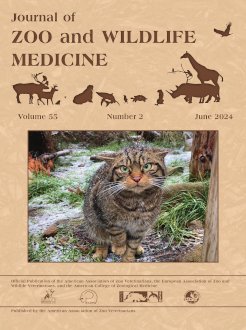Parrot bornaviruses are responsible for proventricular dilatation disease (PDD) in psittacines. This study aimed to determine the occurrence and factors associated with Parrot bornaviruses infection in psittacines kept in captivity in a state in the southern region of Brazil. A cross-sectional study was carried out with 192 birds from two facilities (A and B) in 2019, using choanal, esophageal, and cloacal swabs and feathers, totaling 768 samples subjected to reverse-transcription polymerase chain reaction (RT-PCR), for the matrix (M) protein gene with a final product of 350 base pairs (bp). Genetic sequencing of three positive samples was performed by the Sanger method. In the study, the overall virus occurrence was 35.9% (69/192), with 40.4% (42/104) in Facility A and 30.7% (27/88) in Facility B. Sequencing analysis of the samples revealed the presence of Parrot bornavirus 2 (PaBV-2) in both facilities. Swab samples from the choanal (40/69), esophageal (30/69), cloacal (35/69), and feather (15/69) tested positive, facilitating the molecular diagnosis of Parrot bornaviruses. The results indicated that there is no single ideal sample type for antemortem molecular diagnosis of this virus. Simultaneously testing all four samples at the same time point yielded more diagnoses than testing any single sample among the four. Most of the 29 sampled psittacine species were native, and 46.9% of the birds (90/192) consisted of endangered species. Among the psittacines that tested positive, 88.4% (61/69) were clinically healthy, and 8.7% (6/69) exhibited clinical or behavioral signs, including behavioral changes, alterations in feathering, and changes in body score at the time of collection. This study showcases the application of minimally invasive sampling for diagnosing Parrot bornaviruses, enabling sample collection when the birds are restrained for clinical evaluation. This approach facilitates a prompt and effective antemortem diagnosis, thereby serving as an efficient screening method for parrots kept in captivity.
How to translate text using browser tools
13 June 2024
PARROT BORNAVIRUSES IN PSITTACINES KEPT IN CAPTIVITY IN THE STATE OF SANTA CATARINA, BRAZIL
Sara E. Schmitt,
Gabriela B. das Neves,
Jéssica A. Withoeft,
Leonardo S. Costa,
Giovana Biezus,
Rafael S. Pagani,
Luiz C. Miletti,
Ubirajara M. Costa,
Renata A. Casagrande
ACCESS THE FULL ARTICLE





